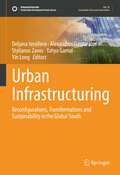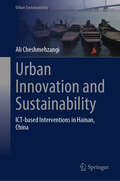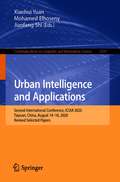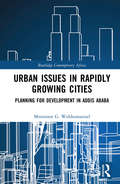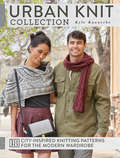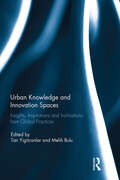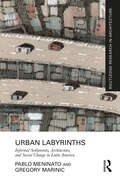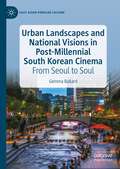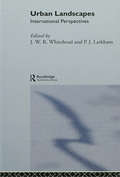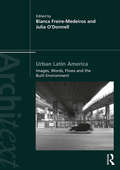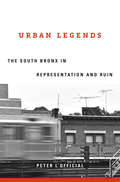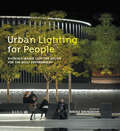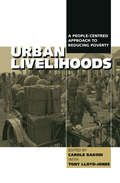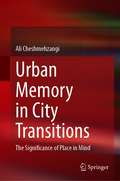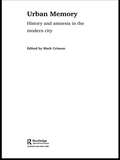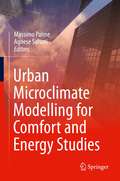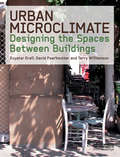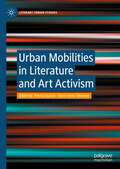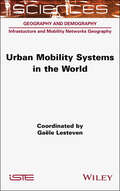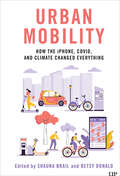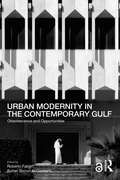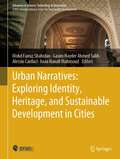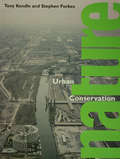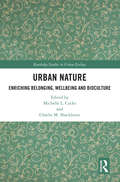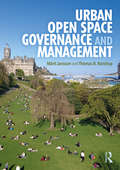- Table View
- List View
Urban Infrastructuring: Reconfigurations, Transformations and Sustainability in the Global South (Sustainable Development Goals Series)
by Alexandros Gasparatos Deljana Iossifova Stylianos Zavos Yahya Gamal Yin LongThis book is about urban infrastructuring as the processes linking infrastructural configurations and their components with other social, ecological, political, or otherwise defined systems as part of urbanisation and globalisation in the Global South. It suggests that infrastructuring is essential to urbanisation and that it is entangled with socio-spatio-ecological transformations that often have negative outcomes over time. Furthermore, it argues that infrastructuring requires an ethical positioning in research and practice in order to enhance infrastructural sustainability in the face of intersecting environmental, social and economic crises. “Urban Infrastructuring” is developed in three parts. First, it identifies infrastructural entanglements across various urban and urbanising settings in the Global South. Second, it highlights some of the damaging processes and outcomes of urban infrastructuring and argues that the absence, presence and transformation of infrastructure in the Global South (re-)produces socioecological injustice in the short- and long term. Third, the book argues for a shift of infrastructuring agendas towards more just and sustainable interventions. It suggests that an ethico-politics of care should be embedded in systems approaches to infrastructuring in both research and practice. The edited volume contains contributions from authors with backgrounds in a variety of academic disciplines from the natural and social sciences, engineering and the humanities. It provides valuable insights for anyone concerned with the study, design, planning, implementation and maintenance of urban infrastructures to enhance human well-being and sustainability. It will be of interest to researchers and urban decision-makers alike.
Urban Innovation and Sustainability: ICT-based Interventions in Hainan, China (Urban Sustainability)
by Ali CheshmehzangiThis book is a collection of context-specific ICT-based interventions to achieve sustainability from various perspectives or dimensions. The book is based on case study examples in the strategic context of Hainan, South China. Five ICT-based pilot studies were conducted, surveyed, and analysed in 2021 and 2022. The studies explore impacts on four main sustainability dimensions of environmental, social, economic, and institutional. Several ICT-based interventions are suggested to enhance environmental protection, promote health and support in elderly communities, augment social media for place promotion, create online opportunities for local markets, and help boost local tourism industries. Urban Innovation and Sustainability is an attempt to highlight the positive side of ICT-based interventions in cities and communities. We also need to note the negative side of ICTs, which are partly covered in the case study examples. However, this book focuses on case study pilot examples to promote the nexus between innovation and sustainability. It is essential to explore opportunities that could later be scaled up, transform practices, and help develop context-specific policies. In essence, paradigm shifts, infrastructural development, and human-centric development are necessary. This book&’s findings interest scholars/researchers, practitioners, and authorities in various disciplines of urbanism, urban/human geography, urban studies, planning, innovation, and sustainability.
Urban Intelligence and Applications: Second International Conference, ICUIA 2020, Taiyuan, China, August 14–16, 2020, Revised Selected Papers (Communications in Computer and Information Science #1319)
by Mohamed Elhoseny Xiaohui Yuan Jianfang ShiThis book constitutes revised papers from the Second International Conference on Urban Intelligence and Applications, ICUIA 2020, held in August 2020. Due to the COVID-19 pandemic the conference was held online. The 26 papers were thoroughly reviewed and selected from 122 submissions. They are organised in the topical sections on technology and infrastructure; community and wellbeing; mobility and transportation; security, safety, and emergency management.
Urban Issues in Rapidly Growing Cities: Planning for Development in Addis Ababa (Routledge Contemporary Africa)
by Mintesnot G. WoldeamanuelThis book critically assesses the complex urban issues, planning challenges and development opportunities of rapidly growing cities, using Addis Ababa as a case study. Just like other developing cities, Addis Ababa is undergoing numerous natural and policy-driven changes. This book analyses the effect of these changes on urban management to allow better understanding of the conceptual frameworks that define the everyday functions of rapidly growing cities. It demonstrates that rapid urban growth has simultaneously created opportunities for economic development in the developing world as well as social, environmental and cultural challenges causing a mismatch between demand and the supply of services. The author argues that, by combining indigenous knowledge and practices and contemporary planning principles, developing countries can overcome challenges concerning environmental and public health, transport congestion, rising rents and house prices and lack of open space. Foregrounding the experience of everyday citizens of the city, this book aids our understanding of the nature of rapidly growing cities and outlines what needs to be done so that the city meets the needs of the people. A unique contribution to the literature on cities of the developing world, this book will be of interest to students and scholars of Urban Studies, Planning, Development Studies and African Studies.
Urban Knit Collection: 18 City-Inspired Knitting Patterns for the Modern Wardrobe
by Kyle KunneckeStylish knitwear with a timeless appeal!<P><P> Big city style meets classic design in this gorgeous guide for the contemporary crafter! Inspired by 20th century architectural elements, Urban Knit Collection offers 18 DIY projects for women and men with a decidedly metropolitan vibe. From Art Deco- and stained glass-inspired sweaters to the beaded Ritz Cowl and Skyscraper Hat, author Kyle Kunnecke's innovative designs evoke the beauty of a cityscape in runway-worthy knits that you can customize to reflect your personal style.<P> Written for would-be and longtime knitters alike, Kyle's detailed patterns include tutorials on a variety of construction and finishing techniques, from locking floats and knitting on round needles to reading charts and choosing yarn. Whether your style is uptown, downtown, or somewhere in between, Urban Knit Collection has you covered!
Urban Knowledge and Innovation Spaces: Insights, Inspirations and Inclinations from Global Practices
by Tan YigitcanlarThe expansion of knowledge economy, globalization, and economic competitiveness has imparted importance of knowledge and innovation in local economies worldwide. As a result, integrating knowledge generation and innovation considerations in urban planning and development processes has become an important agenda for establishing sustainable growth and long-term competitiveness of contemporary cities. Today, making space and place that concentrate on knowledge generation and innovation is a priority for many cities across the globe. Urban knowledge and innovation spaces are integrated centres of knowledge generation, learning, commercialization and lifestyle. In other words, they are high-growth knowledge industry and worker clusters, and distinguish the functional activity in an area, where agglomeration of knowledge and technological activities has positive externalities for the rest of the city as well as firms located there. Urban knowledge and innovation spaces are generally established with two primary objectives in mind: to be a seedbed for knowledge and technology and to play an incubator role nurturing the development and growth of new, small, high-technology firms; and to act as a catalyst for regional economic development that promotes economic growth and contributes to the development of the city as a ‘knowledge or innovative city’. This book contains chapters reporting investigation findings on different aspects of urban knowledge and innovation spaces, such as urban planning and design, innovation systems, urban knowledge management, and regional science. It was originally published as a special issue of the Journal of Urban Technology.
Urban Labyrinths: Informal Settlements, Architecture, and Social Change in Latin America (Routledge Research in Architecture)
by Gregory Marinic Pablo MeninatoUrban Labyrinths: Informal Settlements, Architecture, and Social Change in Latin America examines intervention initiatives in informal settlements in Latin American cities as social, spatial, architectural, and cultural processes. From the mid-20th century to the present, Latin America and other regions in the Global South have experienced a remarkable demographic trend, with millions of people moving from rural areas to cities in search of work, healthcare, and education. Without other options, these migrants have created self-built settlements mostly located on the periphery of large metropolitan areas. While the initial reaction of governments was to eliminate these communities, since the 1990s, several Latin American cities began to advance new urban intervention approaches for improving quality of life. This book examines informal settlement interventions in five Latin American cities: Rio de Janeiro, Medellín, São Paulo, Buenos Aires, and Tijuana. It explores the Favela-Bairro Program in Rio de Janeiro during the 1990s which sought to improve living conditions and infrastructure in favelas. It investigates projects propelled by Social Urbanism in Medellín at the beginning of the 2000s, aimed at revitalizing marginalized areas by creating a public transportation network, constructing civic buildings, and creating public spaces. Furthermore, the book examines the long-term initiatives led by SEHAB in São Paulo, which simultaneously addresses favela upgrading works, water pollution remediation strategies, and environmental stewardship. It discusses current intervention initiatives being developed in informal settlements in Buenos Aires and Tijuana, exploring the urban design strategies that address complex challenges faced by these communities. Taken together, the Latin American architects, planners, landscape architects, researchers, and stakeholders involved in these projects confirm that urbanism, architecture, and landscape design can produce positive urban and social transformations for the most underprivileged.This book will be of interest to students, researchers, and professionals in planning, urbanism, architecture, urban design, landscape architecture, urban geography, public policy, as well as other spatial design disciplines.
Urban Landscapes and National Visions in Post-Millennial South Korean Cinema: From Seoul to Soul (East Asian Popular Culture)
by Gemma BallardThis book explores South Korean cinema’s inimitable relationship with the urban landscape and identifies the ways in which Seoul is utilised as a celluloid canvas, national artefact and, above all else, a distinctive cultural backdrop. Using five different approaches to urban space, from five distinctive and contrasting theoretical perspectives, Urban Landscapes in Post-Millennial South Korean Cinema investigates and seeks to understand why the cinematic representation, identity and presence of Seoul have been central to the preservation and recognition of the South Korean film industry as an independent, autonomous and nationally unique institution.
Urban Landscapes: International Perspectives (Institute Of British Geographers Special Publication)
by P. J. Larkham J. W. R. WhitehandTaking a multidisciplinary approach this addresses the academic and practical issues concerning the present and future of the built environment, arguing for its enlightened management in the future of our present-day environment.
Urban Latin America: Images, Words, Flows and the Built Environment (Architext)
by Julia O'Donnell Bianca Freire-MedeirosUrban Latin America explores the relationship between images, words and the built environment using an engaging variety of methods and sources, with a timely emphasis on comparative studies. The book brings together scholars with various disciplinary backgrounds and theoretical affiliations who critically approach urban experiences through visual accounts, texts and architectural elements. The reader is introduced to major theories, secondary sources and empirical references that have not been written about in English. Film and photography, fictional and historical writings, particular buildings and landmarks – all inspire fascinating glimpses into different moments in the biography of cities in Argentina, Brazil, Chile, Colombia, Ecuador, Mexico, Uruguay and Venezuela.
Urban Legends: The South Bronx in Representation and Ruin
by Peter L'OfficialA cultural history of the South Bronx that reaches beyond familiar narratives of urban ruin and renaissance, beyond the “inner city” symbol, to reveal the place and people obscured by its myths. For decades, the South Bronx was America’s “inner city.” Synonymous with civic neglect, crime, and metropolitan decay, the Bronx became the preeminent symbol used to proclaim the failings of urban places and the communities of color who lived in them. Images of its ruins—none more infamous than the one broadcast live during the 1977 World Series: a building burning near Yankee Stadium—proclaimed the failures of urbanism. Yet this same South Bronx produced hip hop, arguably the most powerful artistic and cultural innovation of the past fifty years. Two narratives—urban crisis and cultural renaissance—have dominated understandings of the Bronx and other urban environments. Today, as gentrification transforms American cities economically and demographically, the twin narratives structure our thinking about urban life. A Bronx native, Peter L’Official draws on literature and the visual arts to recapture the history, people, and place beyond its myths and legends. Both fact and symbol, the Bronx was not a decades-long funeral pyre, nor was hip hop its lone cultural contribution. L’Official juxtaposes the artist Gordon Matta-Clark’s carvings of abandoned buildings with the city’s trompe l’oeil decals program; examines the centrality of the Bronx’s infamous Charlotte Street to two Hollywood films; offers original readings of novels by Don DeLillo and Tom Wolfe; and charts the emergence of a “global Bronx” as graffiti was brought into galleries and exhibited internationally, promoting a symbolic Bronx abroad. Urban Legends presents a new cultural history of what it meant to live, work, and create in the Bronx.
Urban Lighting for People: Evidence-Based Lighting Design for the Built Environment
by Navaz DavoudianLighting has the power to illuminate and enhance our experience within the built environment. The light that enables people to travel around their neighbourhood or their city; the light which they see themselves and their neighbourhood under. Research into the effects of urban lighting on behaviour, environmental psychology and social interaction is developing at a rapid rate. Yet, despite the affect it has on our daily lives, the practical application of this research is a relatively untapped resource. This book explores the needs and experiences of people at night and how these can be addressed by public lighting. It will give readers the confidence to develop more sophisticated lighting plans and add value to their projects. Case studies provide in-depth analysis of real-life projects and will help the reader to understand lighting designers’ own experiences, including post-installation observations. Written in an accessible style by an array of experts, this is an essential book for practitioners, academics and students alike, that will enable you to put the research in to practice and develop better lighting for better places.
Urban Livelihoods: A People-centred Approach to Reducing Poverty
by Carole Rakodi Tony Lloyd-JonesOne of the most promising approaches to poverty reduction in developing countries is to encourage sustainable livelihoods for the poor. This takes account of their opportunities and assets and the sources of their vulnerability. Based on recent and extensive research, this volume thoroughly assesses the value of the livelihoods approach to urban poverty. The book reviews the situation and strategies of the urban poor and identifies the policies and practical programmes that work best. Lasting improvements depend not just on economic development, but on political commitment and structures that are responsive to the claims and needs of different groups of poor people.
Urban Memory in City Transitions: The Significance of Place in Mind
by Ali CheshmehzangiAs a continuation of ‘Identity of Cities and City of Identities’, this book covers the arguments around the memory-experience-cognition nexus concerning palimpsests and urban places. As cities experience transitional phases of growth, development, decline, and decay, the author urges considering the notion of urban memory in place-making strategies and design decision-making processes. These explorations would add value to primary fields of architecture, architectural history, cognitive science, human geography, and urbanism. Divided into eight chapters, this book puts together a comprehensive knowledge of urban memory in city transitions. By studying urban memory, the author delves into conceptions of mental mapping, knowledge of environments, cognition of places, and the perceptual dimension of urbanism. Undoubtedly, urban memory plays a significant part in the future movements of humanistic urbanism. Given the significances of scale, pace, and mode of city transitions globally, we should remember who are the ultimate users of those living environments. Therefore, in this book, the author debates two contradictions of ‘memory of place vs. place of memory’, and ‘significance of place vs. place of significance’. Each of these is believed to be a paradox of its own, indicating places are significant through the systematic networks of cities, memories are meaningful through the neural information processing, and place memories are the essence of urban identities.The book's ultimate goal is to demonstrate the effectiveness of the space-time frame of place in making memorable places. Through the comprehensive explorations of many global examples, we can evaluate the significance of place in mind more carefully. This is narrated based on the recognition of nostalgia in cities, socio-temporal qualities in places, and the network of processes in our minds. In return, the aim is to provide new knowledge to make memorable cities, enhance social experiences, and capture and value the significance of place in mind.
Urban Memory: History and Amnesia in the Modern City
by Mark CrinsonNine previously unpublished essays form an interdisciplinary assessment of urban memory in the modern city, analysing this burgeoning area of interest from the perspectives of sociology, architectural and art history, psychoanalysis, culture and critical theory. Featuring a wealth of illustrations, images, maps and specially commissioned artwork, this work applies a critical and creative approach to existing theories of urban memory, and examines how these ideas are actualised in the forms of the built environment in the modernist and post-industrial city. A particular area of focus is post-industrial Manchester, but the book also includes studies of current-day Singapore, New York after 9/11, modern museums in industrial gallery spaces, the writings of Paul Auster and W.G. Sebald, memorials built in concrete, and contemporary art.
Urban Microclimate Modelling for Comfort and Energy Studies
by Massimo Palme Agnese SalvatiThis book discusses urban microclimate and heat-related risks in urban areas, brought on by the combination of global climate change effects and local modification of climate determined by extensive urbanization such as the ‘Urban heat island’ phenomenon. This matter is relevant to almost all urbanized areas in the world, where the increase of urban population and air temperature is expected to endanger both the overall health of the population and the energy supply for the functioning of urban systems. The book details the inter-relationship between urban morphology, microclimate and building energy performance and presents a multidisciplinary approach that brings together Urban Climatology, Engineering and Architectural knowledge to support the development of reliable models and tools for research and practice. This book is a useful tool for architects and building energy modelers, urban planners and geographers who need a practical guide to realize basic urban microclimate simulation for use in both academic research and planning practice.
Urban Microclimate: Designing the Spaces Between Buildings
by David Pearlmutter Evyatar Erell Terence WilliamsonThe quality of life of millions of people living in cities could be improved if the form of the city were to evolve in a manner appropriate to its climatic context. Climatically responsive urban design is vital to any notion of sustainability: it enables individual buildings to make use of renewable energy sources for passive heating and cooling, it enhances pedestrian comfort and activity in outdoor spaces, and it may even encourage city dwellers to moderate their dependence on private vehicles. Urban Microclimate bridges the gap between climatology research and applied urban design. It provides architects and urban design professionals with an understanding of how the structure of the built environment at all scales affects microclimatic conditions in the space between buildings, and analyzes the interaction between microclimate and each of the elements of the urban landscape. In the first two sections of the book, the extensive body of work on this subject by climatologists and geographers is presented in the language of architecture and planning professionals. The third section follows each step in the design process, and in part four a critical analysis of selected case study projects provides a demonstration of the complexity of applied urban design. Practitioners will find in this book a useful guide to consult, as they address these key environmental issues in their own work.
Urban Mobilities in Literature and Art Activism (Literary Urban Studies)
by Patricia García Anna-Leena ToivanenUrban Mobilities in Literature and Art Activism explores the entwinement of mobility and immobility in urban spaces by focusing on their representation in literary narratives but also in visual and performing arts. Across a range of geographical contexts, this volume builds on the new mobilities paradigm developed by literary scholars, sociologists and human geographers. The different chapters employ a cohesive framework that is sensitive to the intersecting dimensions of power and discrimination that shape urban kinetic features. The contributions are divided into three sections, each of which places the focus on a different aspect of urban mobility: Itinerant Subjects, Modes of Transport and Places of Transit, and Urban Liminalities.Chapter 7, "Alienation, Abjection and the Mobile Postcolonial City: Public Transport in Ousmane Sembène’s “Niiwam” and Yvonne Vera’s Without a Name" is available open access under a Creative Commons Attribution 4.0 International License via link.springer.com.
Urban Mobility Systems in the World
by Gaële LestevenUrban Mobility Systems in the World provides insight into the geographical organization of urban mobility systems around the world. These “systems” consist of infrastructure networks, existing transport services and people’s travel practices. Adopting a comparative approach, the book highlights the geographical diversity of mobility systems, based on case studies from Africa, North and South America, Asia and Europe. This multi-disciplinary book is organized into twelve chapters, divided into four parts. The first part gives an overview of urban mobility, and then examines the factors that determine everyday mobility in cities, revealing different travel practices among populations (poor, elderly and children). Parts 2 and 3, respectively, focus on urban public transport (trains, metros, minibuses) and active modes of transport (walking, cycling), and the related infrastructure policies. The final section examines the circulation of urban mobility analysis tools and public policy models
Urban Mobility: How the iPhone, COVID, and Climate Changed Everything
by Shauna Brail Betsy DonaldUrban Mobility sheds light on mobility in twenty-first-century Canadian cities. The book explores the profound changes associated with technological innovation, pandemic-induced impacts on travel behaviour, and the urgent need for mobility to respond meaningfully to the climate crisis. Featuring contributions from leading Canadian and American scholars and researchers, this edited collection traverses disciplines including geography, engineering, management, policy studies, political science, and urban planning. Chapters illuminate novel research findings related to a variety of modes of mobility, including public transit, e-scooters, bike-sharing, ride-hailing, and autonomous vehicles. Contributors draw out the connections between urban challenges, technological change, societal need, and governance mechanisms. The collection demonstrates why the smart phone, COVID-19, and climate present a crucial lens through which we can understand the present and future of urban mobility. The way we move in cities has been disrupted and altered because of technological innovation, the lingering impacts of COVID-19, and efforts to reduce transport-related emissions. Urban Mobility concludes that the path forward requires good public policy from all levels of government, working in partnership with the private sector and non-profits to direct and address the best urban mobility framework for Canadian cities.
Urban Modernity in the Contemporary Gulf: Obsolescence and Opportunities
by Roberto Fabbri Sultan Sooud Al-QassemiUrban Modernity in the Contemporary Gulf offers a timely and engaging discussion on architectural production in the modernization era in the Arabian Peninsula. Focusing on the 20th century as a starting point, the book explores the display of transnational architectural practices resulting in different notions of locality, cosmopolitanism, and modernity. Contextually, with an eye on the present, the book reflects on the initiatives that recently re-engaged with the once ville moderne which, meanwhile, lost its pivotal function and meaning. A city within a bigger city, the urban fabric produced during the modernization era has the potential to narrate the social growth, East–West dynamics, and citizens’ memories of the recent past. Reading obsolescence as an opportunity, the book looks into this topic from a cross-country perspective. It maps, reads and analyses the notion of modern heritage in relation to the contemporary city and looks beyond physical transformations to embrace cultural practices and strategies of urban re-appropriation. It interrogates the value of modern architecture in the non-West, examining how academic research is expanding the debate on Gulf urbanism, and describes how practices of reuse could foster rethinking neglected areas, also addressing land consumption in the GCC. Presenting a diverse and geographically inclusive authorship, which combines established and up-and-coming researchers in the field, this is an important reference for academics and upper-level students interested in heritage studies, post-colonial urbanism, and architecture in the non-West.
Urban Narratives: Exploring Identity, Heritage, and Sustainable Development in Cities (Advances in Science, Technology & Innovation)
by Gasim Hayder Ahmed Salih Mohd Fairuz Shahidan Alessio Cardaci Israa Hanafi MahmoudThis book engages readers in an enlightening exploration of cities' identities, sustainability, and urban development. Delving into the intricate interplay between art, architecture, and the urban landscape, it offers a compelling analysis of the factors that shape cities and their distinct personalities. The volume uncovers captivating stories of cities as they navigate the delicate balance between heritage conservation and modernity. It highlights innovative strategies employed to preserve historical sites while adapting to the demands of a rapidly changing world. Full of insightful discussions on the impact of cultural lifestyles, the fusion of architectural styles, and the challenges and triumphs of sustainable urban development, it draws upon a diverse range of perspectives and research, inviting architects, urban planners, and scholars to delve into the intricate nuances of cities' identities in the process.With its informative and engaging narrative, this book providesa fresh perspective on cities' identities and offers practical insights into shaping vibrant, livable urban landscapes.
Urban Nature Conservation: Landscape Management in the Urban Countryside
by Stephen Forbes Tony KendleUrban nature conservation is a field that has grown rapidly in importance over the past 20 years and will continue to do so in the coming years as landscape ecology and greenspace planning become established disciplines. A widespread concern and interest in the wild plants and animal life found in urban areas now influences the policies and practices of land management organizations. This book provides a comprehensive overview of the subject. It will assist professionals in formulating strategic management policies that integrate urban nature conservation into the wider context of landscape management and urban planning.
Urban Nature: Enriching Belonging, Wellbeing and Bioculture (Routledge Studies in Urban Ecology)
by Michelle L. Cocks and Charlie M. ShackletonThis book showcases the diversity of ways in which urban residents from varying cultural contexts view, interact, engage with and give meaning to urban nature, aiming to counterbalance the dominance of Western depictions and values of urban nature and design. Urban nature has up to now largely been defined, planned and managed in a way that is heavily dominated by Western understandings, values and appreciations, which has spread through colonialism and globalisation. As cities increasingly represent a diversity of cultures, and urban nature is being increasingly recognised as contributing to residents' wellbeing, belonging and overall quality of life, it is important to consider the numerous ways in which urban nature is understood and appreciated. This collection of case studies includes examples from Africa, Asia, Europe, North and South America, and reflects on the multi-dimensional aspects of engagements with urban nature through a biocultural diversity lens. The chapters cover several themes such as how engagements with nature contribute to a sense of wellbeing and belonging; the implications that diversity has on the provision, design and management of urban environments; and the threats inhibiting residents’ abilities to engage meaningfully with nature. The book challenges the dominant discourse, Western ideological understandings and meta-narratives of modernisation and unilineal urban transitions. A timely addition to the literature, Urban Nature: Enriching Belonging, Wellbeing and Bioculture offers an alternative to Western ideological understandings of nature and values and will be of great interest to those working in human and environmental urban ecology. It will also be key reading for students in the relevant fields of anthropology, development studies, geography, social ecology and urban studies.
Urban Open Space Governance and Management
by Märit Jansson Thomas B. RandrupThis edited volume defines and compares central aspects of governance and management related to urban open spaces (UOSs) such as long-term management, combined governance and management and strategic management of UOSs. Perspectives such as ethical considerations, user participation and changes in local governmental structures frame the governance and management of UOSs. Jansson and Randrup create a comprehensive resource detailing global trends from framing and understanding to finally practising UOS governance and management. They conclude by promoting positive changes, such as proactive management and strategic maintenance plans to encourage the creation of more sustainable cities. Illustrated in full colour throughout, this book is an essential read for students and academics of landscape architecture, planning and urban design, as well as those with a particular interest in governance and management of UOSs.
